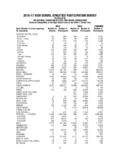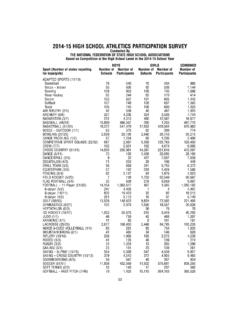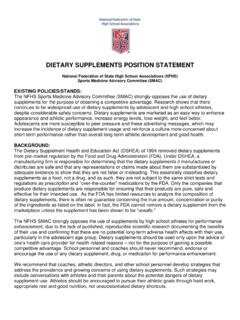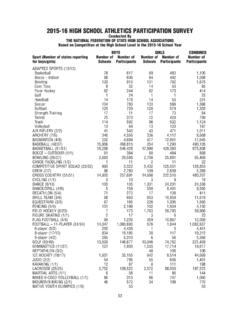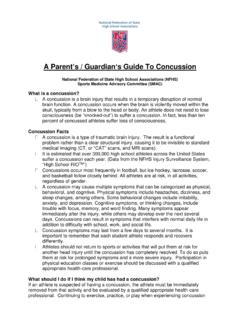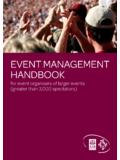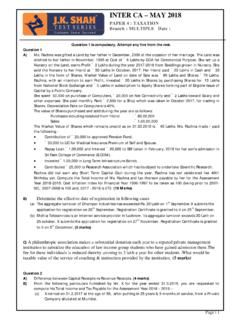Transcription of Recommendations and Guidelines for Minimizing Head …
1 1 Recommendations and Guidelines for Minimizing Head Impact Exposure and Concussion Risk in football National Federation of State High School Associations ( nfhs ) Report from the July 2014 nfhs Concussion Summit Task Force The National Federation of State High School Associations ( nfhs ) and its member associations firmly believe that athletic participation by students promotes health and fitness, academic achievement, healthy lifestyles, and good citizenship. While there will always be a risk of injury, Minimizing the risk of head trauma and concussion in all sports is a priority for the nfhs . Over the past several years, the nfhs and the nfhs Sports Medicine Advisory Committee (SMAC) have: 1) Produced a 20-minute online educational course with the Centers for Disease Control (CDC) on Concussion in Sports.
2 2) Specifically addressed concussion management in the rules books of all sports, including football . 3) Written several Points of Emphasis in the football rules book focused on limiting helmet-to-helmet contact and blows to the head with the shoulder, forearm, and hand. 4) Disseminated multiple publications regarding concussion management to the member state associations. In July of 2014, at the request of the nfhs Board of Directors, a task force of medical and scientific experts, high school football coaches, state association personnel, and representatives of several stakeholder organizations met to discuss strategies to reduce head impacts and minimize concussion risk in high school football players during contests and practices, as well as during activities conducted outside of the traditional fall football season (spring and summer practices).
3 The Fundamentals outlined below represent the task force s Recommendations and Guidelines developed following two days of presentations and discussion of the relevant medical literature and current expert opinion. The members of the task force fully acknowledge the present limited though evolving scientific evidence available to support the Fundamentals outlined below with absolute certainty and explicit detail. Accordingly, the outcomes and clinical relevance of an increasing number of research studies may eventually alter these Recommendations and Guidelines . Ideally, this emerging data will clarify the potential for long-term adverse cognitive, emotional, and/or neurologic effects from concussions and repetitive blows to the head that may not result in the clinical symptoms of concussion.
4 Based on what is currently known, the guiding principles in developing this report for young athletes and those who oversee, support and administer high school football programs were to reasonably limit overall 2 exposure to multiple blows to the head and body (head impact exposure) and minimize concussion risk, while maintaining the integrity of the game and attempting to avoid unintended consequences. The Fundamentals below are designed to allow flexibility for the state associations that collectively oversee the more than 15,000 high schools playing football across the country. The teams fielded by these schools may vary tremendously in the number of available players. Team size dictates numerous variables that may affect an athlete s potential head impact exposure.
5 Those variables cannot be easily accounted for by stringent Guidelines . For example: An athlete playing on offense, defense and special teams will have greater cumulative head impact exposure and will be at higher risk for injury than an athlete playing a single position. The fewer the number of players on a team, the greater the chance some players will need to participate in repeated drills, raising head impact exposure and potential injury risk. As additional evidence emerges, these Fundamentals will evolve and may become more or less restrictive. While the current level of knowledge keeps this task force from making proposals that are specific and rigid, there is consensus that lessening the frequency of contact (and thus head impact exposure) is likely beneficial to overall brain health.
6 The task force also recognizes multiple contributing factors that affect head impact exposure and the parallel effects on an individual football player s brain. For example: Position played (linemen receive more total blows than other positions) Two-way players versus those who only play offense or defense Tackling and blocking techniques Practice frequency and duration Players that practice and/or compete on multiple levels (such as varsity and sub-varsity)* Concussion history Genetic predisposition to concussion *Note: This contributing factor was added to the document by the nfhs SMAC. It is very likely that each athlete has a unique level of resilience or susceptibility to concussion and further brain injury.
7 While there is currently no definitive way to measure or quantify this resilience or susceptibility, the task force recommends reasonably limiting head impact exposure through the Fundamentals presented below. Individual risk factors that are modifiable, such as position played, total time spent on field, and sport technique, must be also considered when implementing contact limitations. Fundamentals for Minimizing Head Impact Exposure and Concussion Risk in football 1. Full-contact should be limited during the regular season, as well as during activity outside of the traditional fall football season. For purposes of these Recommendations and Guidelines , full-contact consists of both Thud and Live Action using the USA football definitions of Levels of Contact.
8 Rationale: By definition, Thud involves initiation of contact at, or up to, full speed with no pre-determined winner and no take-down to the ground. Accordingly, the task force supports that initial contact, particularly with linemen, is just as violent with Thud as with Live Action. However, the task force also recognizes that Live Action likely carries a higher risk for other 3 injuries to the body than does Thud. The USA football Levels of Contact Air, Bags, and Control are considered no- or light-contact, and thus no limitations are placed on their use. 2. Member state associations should consider a variety of options for limiting contact in practices. The task force strongly recommends full-contact be allowed in no more than 2-3 practices per week.
9 Consideration should also be given to limiting full-contact on consecutive days and limiting full-contact time to no more than 30 minutes per day and no more than 60-90 minutes per week. Rationale: The task force acknowledges that there are insufficient data to specify with certainty a research-validated best practices standard for contact limitations. Several states (Alabama, Arizona, Maryland, and Texas) adopted varying limitations on contact prior to the 2013 football season. Preliminary High School RIO injury surveillance data suggest these states have seen a statistically significant decrease in concussion rates during practices, with no increase in concussion or other injuries during games. 3. Pre-season practices may require more full-contact time than practices occurring later in the regular season, to allow for teaching fundamentals with sufficient repetition.
10 A. Pre-season acclimatization protocols and regulations regarding heat and hydration take precedent and should always be followed. B. While total full-contact practice days and time limitations may be increased during the pre-season, the emphasis should focus on the proper principles of tackling and blocking during the first several practices, before progressing to Thud and Live Contact. Rationale: The task force acknowledges regular season practice limitations may need to be revised during the pre-season. This should be done in a specific and systematic manner to allow coaches to spend sufficient time teaching proper tackling and blocking techniques. Emphasis should be placed upon inexperienced players, as they slowly work through tackling and blocking progressions with Air, Bags, and Control using the USA football definitions of Levels of Contact.

